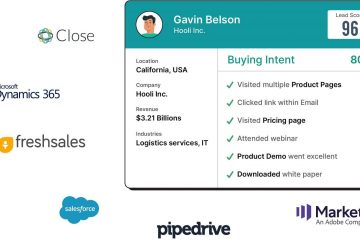User Funnels: How To Identify Funnel Drop-Offs?
What does every marketer dream of? Amazing conversion rates!
However, more often than not, you may find warm (or even hot) leads dropping off in the middle of the journey. It could be because of a technical issue like slow loading for webpages or something to do with usability; however, the end result is the same, i.e., no revenue for your business.
This is why it is super important to evaluate user funnels and track funnel drop-off rates. Locating and remedying the underlying issue(s) leading to funnel drop-offs can not only boost product engagement but also increase conversion rates. Identifying funnel drop-off points can be especially useful for SaaS companies in helping them increase free-trial-to-paid-subscription conversions, user experience and retention, and expansion revenue.
In this blog, we will provide you with a brief overview of user funnels and funnel drop-offs and enlighten you about their common causes. We will also discuss how you can calculate your website’s funnel drop-off rate and reduce it for conversion optimization throughout your customer journey.
Brief Overview of User Funnels
So, what is a user funnel? A user funnel is essentially a visualization of the steps users take to achieve a specific goal, i.e., conversion, on a website or application. It represents the journey a user follows from lead to paying customer and beyond and helps businesses understand where they should direct their efforts to convert more users.
A user funnel follows the customer’s path from the moment they realize they identify their pain point(s) to learning about your business and through the entire journey. Steps like viewing a webpage, adding products to a cart, or finishing a transaction are all accounted for. Businesses may find areas for improvement, improve user experience, and maximize conversion rates, by examining user behavior at each level of the funnel. This allows them to successfully steer more customers towards the final conversion, which usually involves them paying for a subscription to your product or service.
A user funnel also covers customer behavior after they have already made a purchase from your business. There’s always an opportunity to upsell!
Analyzing the post-purchase behavior of customers can further help businesses provide the latter with a better brand experience, often resulting in improved customer retention, which, in turn, creates a recurring revenue channel for the company.
Now, let’s understand what funnel drop-offs mean.
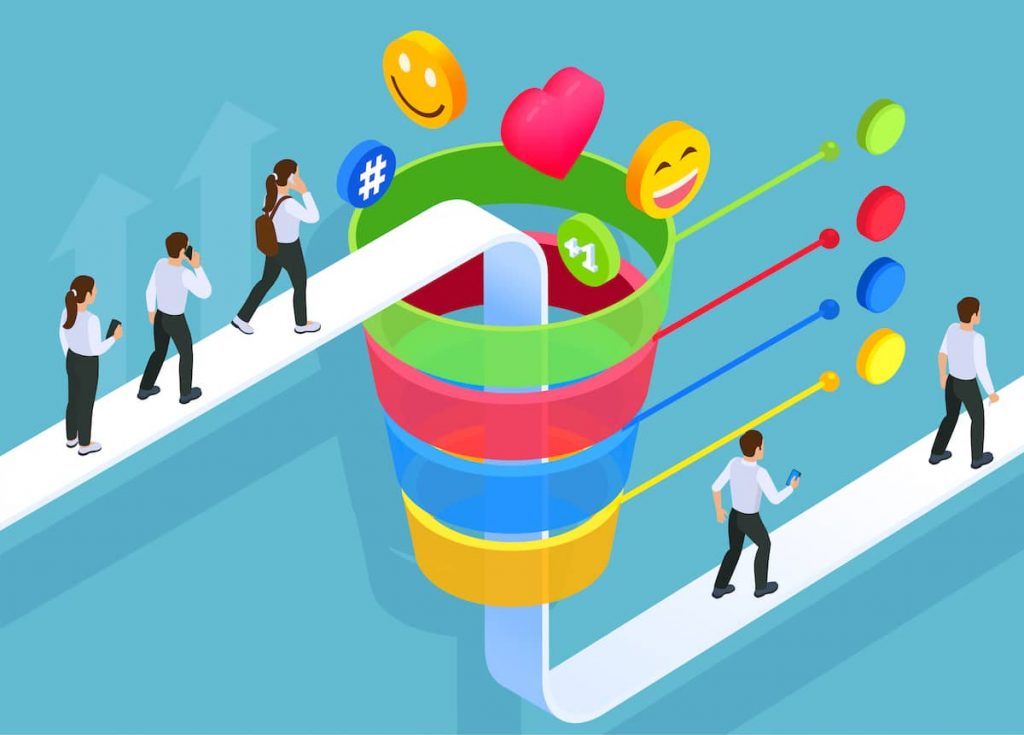
What are Funnel Drop-Offs?
A funnel drop-off refers to the moment or incident that causes users to abandon their purchase on your website or application in the midst of the conversion process. There may be times when a significant portion of users drop off as they proceed through the stages of the journey. This can happen during several stages, including onboarding, trials, activation, and even subscription renewal, usually indicating a major problem with the customer journey or the buying process.
While implementing a user funnel in your SaaS business can help you make data-driven decisions to maximize your conversion rate and pinpoint areas of friction that require improvement, it is imperative to analyze your funnel regularly to pinpoint drop-offs and optimize the funnel for creating a seamless user journey. If funnel drop-offs are not identified and addressed promptly, businesses risk losing potential customers or users at critical stages of the conversion process. This can result in decreased conversion rates and lost revenue opportunities that can ultimately hinder the growth and success of the business.
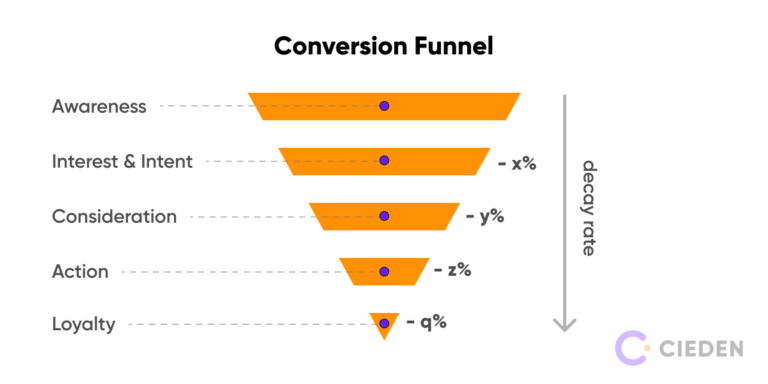
Image Source: Cieden
Common Causes Behind Funnel Drop-Offs
Worried about funnel drop-offs? Well, they are extremely common and usually happen because of the reasons below:
- Friction in User Experience: This is usually the most likely cause. Complicated navigation, broken links, or technical issues, such as slow loading times for webpages, that detract from the user experience, can cause friction. Users may become frustrated and eventually disengaged if they find it difficult to accomplish their goals.
- Lack of Clarity: Potential customers will leave your website if they need assistance understanding your product or why they should buy it, which can result in significant drop-off rates. This challenge may arise due to the use of complex language and technical jargon in the messaging or a lack of material that adequately represents how the product or service works.
- Wrong Target Audience: Another reason for funnel drop-offs can be wrong audience targeting. This happens all the time even if you are defining ICP correctly. Especially in PPC advertising, you end up getting a lot of unqualified traffic to your landing pages. Without the right audience, a proper layout, content, and communication strategy, this can result in a high drop-off rate.
- Steep Learning Curve: For many SaaS products, a steep learning curve can be a major adoption obstacle. When faced with an intricate interface or an abundance of features, customers could become disheartened and lose interest in further exploring the product. Drop-offs may result from this at different points in the funnel, including the initial sign-up, onboarding, and beyond.
- Inadequate Customer Support: Customer support is the first place people will go to when they need help or have questions about your product or service. Quick, kind, and informed customer service can play a big role in keeping customers and avoiding drop-offs. However, unresponsive or inept customer service results in disgruntled customers who stop using the product. Inadequate customer support can foster a lack of brand trust as well, further discouraging potential users from checking out your offering.
These are the most common causes for funnel drop-offs. Before we go into solutions, let’s get into the mathematics so we can understand the severity of the problem.
How To Calculate Funnel Drop-Off Rates?
Calculating the funnel drop-off rate is simple enough. It is calculated as:
Number of People Abandoning the Funnel Mid-Conversion / Total Number of People Who Initiated Conversion Action (s) * 100
For example —
If the total number of people who visited the website is 10000, and the number of people who made some kind of purchase is 200, then the funnel drop-off rate is
9800 / 10000 * 100 = 98%
But, that’s not all. You need to track a few more things to identify leaks in your funnel.
Free-Trial-to-Paid-Conversion Rate
This metric indicates the percentage of people who switch from a free trial to a paid membership. It assesses how well trial users are converted to paying customers.
A high conversion rate shows a successful free trial experience and well-positioned product value. A decline indicates possible problems with pricing transparency, onboarding, or the paid offering’s perceived value.
Formula:
Free Trial to Paid Conversion Rate =
Number of Conversions / Total Number of Free Trial Users * 100
Customer Churn Rate
This metric indicates the percentage of consumers who discontinue using your product over a given time frame.
Elevated churn rates may indicate discontent, insufficient assistance, or unfulfilled user requirements. Reasons for churn must be identified and addressed if you want to decrease funnel drop-offs in your sales pipeline and enhance overall product success.
Formula:
Customer Churn Rate =
Number of Customers Lost During a Specific Time Period / Number of Customers at the Start of the Period * 100
In case your calculations reveal that your funnel drop-off rate is greater than the industry average, you may have a problem on your hands. It is imperative, at this point, to promptly dedicate your time and resources to identifying your funnel drop-off points and implementing strategies that prevent your customers from abandoning the buyer process before they convert into paying customers. This is what we will be discussing in the next section.
Five Ways To Reduce Funnel Drop-Offs in the User Journey
Reducing funnel drop-offs usually requires a multi-faceted strategy, which may not be complex but typically involves a series of steps, including the evaluation of user behavior data, the optimization of your conversion funnel at every level, and the implementation of targeted website upgrades, amongst other things.
Here are five strategies that can help you reduce funnel drops in your user journey (specifically targeted to B2B businesses):
1. Personalized Onboarding Flows
While acquiring new customers might be a challenge, it is important to think about what happens post-purchase. Is your product or service easy to navigate and learn for newly onboarded users? The onboarding flow is an essential part of the user journey, and new users can easily become disinclined to continue with your product if they face obstacles in using it.
So, how can you make sure that there is as little friction as possible between your tool and potential customers? The answer — personalizing your product onboarding flow!
You can do this by gathering information about your new users, understanding the goals they plan to achieve using your product, i.e., the job to be done, and segmenting them to initiate personalized flows. This is the first step in personalizing their onboarding.
To increase customer engagement and pleasure, personalization flows can include tailored messaging, relevant product recommendations, and adaptable tutorials.
2. Use Heatmaps and Session Recordings
Heatmaps and session recordings are very useful in tracking user interactions on your website or application. Let’s describe how each of these works separately.
Heatmaps show which parts of a webpage are most frequently visited by providing a visual representation of user interactions. They serve as an indicator of how frequently or how intensely users engage with the webpage. Heatmaps help marketers prioritize content placement and design features, which in turn, enable them to be certain that product or service information is placed in a way that will pique the attention of their target audience.
You can also use heatmaps in conjunction with product analytics tools, to identify and address friction points at certain user journey stages. Heatmaps may, thus, help you increase the effectiveness of the user flow and increase user engagement, conversion rates, and customer satisfaction. An event occurrence heat map, for instance, can be used to pinpoint the precise location of user dropoff and adjust features accordingly. Heatmaps also allow you to see the exact path users navigate to complete a specific action, in this case, pertaining to conversion. Monitoring every navigational action the user makes within the app to identify any odd ups and downs in page activity can help you identify problems in the customer journey before too many prospects start dropping off your conversion funnel.
Coming to session recordings, these serve the same purpose as heatmaps, albeit, in a slightly different way. Session recordings entail capturing every activity a user does on the website, including mouse clicks, scrolls, and other interactions. Analyzing session recordings can yield insightful information about user activity. Real-time website interaction monitoring allows you to see how users are interacting with your site, pinpoint problems, comprehend user flows, and make changes to improve the user experience.
With session recordings, you can improve site navigation and design, optimize form flow and design, and reduce the bounce rate on your website’s key pages, such as the homepage, landing pages, product pages, and the pricing page. This can directly impact your funnel drop-off rate, reducing it and bringing in more conversions.
3. Streamline the Checkout Process (primarily for eCommerce)
Research indicates that the average cart abandonment rate for eCommerce sites is 69.99%. While this depends on a number of factors, a convoluted checkout process can particularly cause potential customers to drop off the sales funnel. High cart abandonment rates usually indicate bottlenecks in the user experience in the payment process and seriously deter conversions and the ensuing revenue that could come from them.
This applies in the case of B2B businesses as well. Many B2B products, even today, do not offer transparent pricing or multiple pricing tiers. To reduce funnel drop-offs owing to a difficult sign-up process, marketers can optimize the speed and performance of the checkout flow and guide the users through the various checkout stages. This can often create an appealing user experience.
4. Implement On-Page Feedback Surveys
Getting direct feedback from users while they are interacting with your website or application can be a great way to identify what issues they are facing in their customer journey. With advanced technologies like on-page feedback surveys, this is now possible. These questionnaires, which usually show up on the website itself, ask the visitors checking out your website or app for their thoughts, preferences, or experience-related feedback.
Businesses can get real-time feedback regarding usability problems, concerns, or conversion bottlenecks by strategically inserting surveys at key points in the funnel. With the use of this data, they can quickly detect and resolve problems, making the required changes to enhance the user experience. Furthermore, companies that actively seek feedback from their customers show that they value their input and work to earn their loyalty and trust. In the end, this proactive strategy reduces drop-offs, optimizes the funnel, and raises conversion rates all around.
For example, Stripe offers an in-app feedback box on every webpage. When you click it you get a modal to send feedback, with the prompt, “Feedback about this page?”
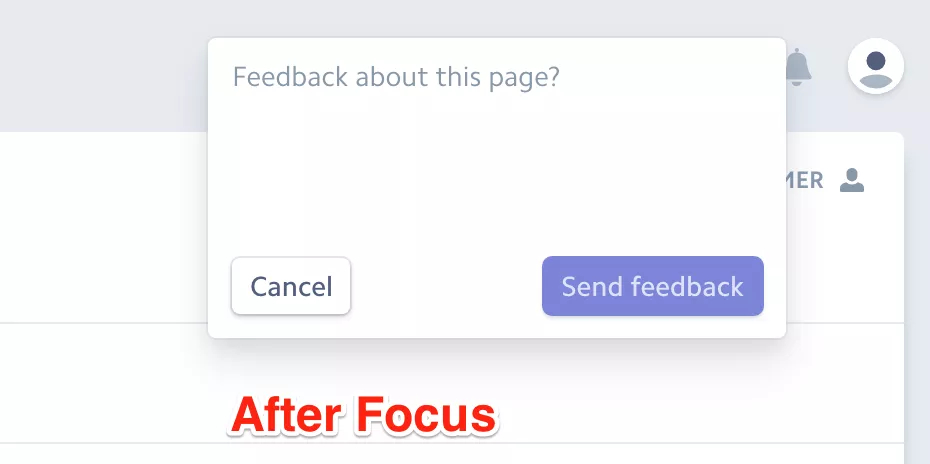
Image Source: savio.io
Once you integrate Stripe’s dashboard with their API, Stripe further provides a pop-up feedback box asking users about their experience. When you select an option, you get an opportunity to leave them qualitative feedback. The prompt they use is, “Tell us more…”
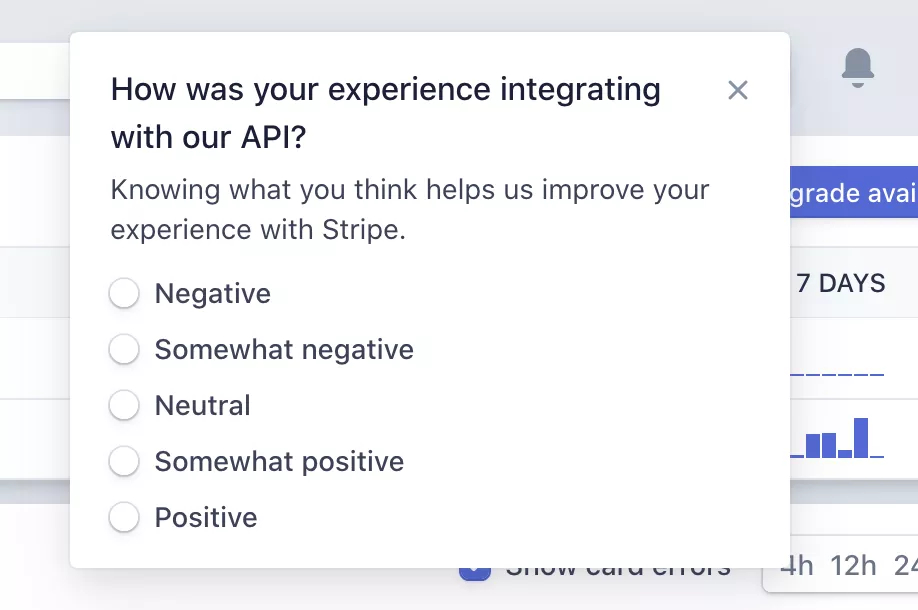
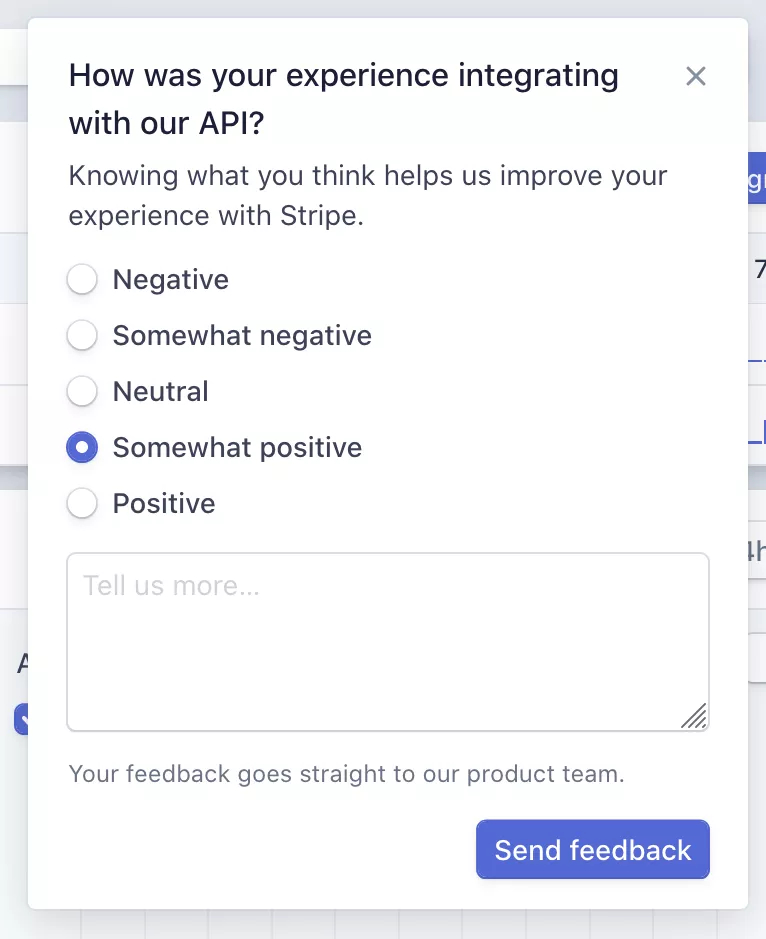
5. Offer Proactive Customer Support
As cited above, a lack of clarity may force new product or service users to drop off the sales funnel. No matter their level of problem awareness or their purchase intent, customers cannot be expected to understand the technicality of your product or service.
This is where proactive customer support comes in.
Businesses can always enhance their self-service support center with the data gathered from drop-off analysis so that customers may quickly identify solutions to their pain points. This strategy can also help increase user engagement, as people are more inclined to stick with a product or when they feel supported and directed through difficulties.
Customer service can become essential in lowering funnel drop-off rates by enabling you to attend to user issues in a timely manner, i.e., during their interactions with your website or application, and offering adequate support during the conversion process. Quick and friendly assistance may clear up problems, answer questions, and help people get past whatever challenges they have.
Businesses guarantee accessibility and ease for users seeking help by providing a variety of communication methods, including live chat, email, and phone support. Positive encounters with support staff also boost user confidence and happiness, which motivates users to move farther down the funnel. In the end, good customer service lowers drop-off rates dramatically by fostering confidence, minimizing friction, and raising the possibility of successful conversions.
How Behavioral Analytics Tools Can Help Track and Reduce Funnel Drop-Offs?
Funnel drop-offs, if not identified and remediated, can be a common issue hurting your conversion rate. To increase your conversion rate, you can pinpoint the areas of the funnel where visitors are leaving and make necessary improvements by knowing what funnel drop is. It is especially important in today’s fiercely competitive business environment, where increasing your conversion rate is essential for success for any type of organization, whether it be B2B or eCommerce.
However, you cannot expect to perform funnel analysis accurately without the right tools. To that end, we would like to introduce you to Salespanel, a B2B visitor intelligence and data-driven marketing software.
Salespanel can help B2B businesses track customer journeys as they engage with your content and website events and analyze visitors in real-time to run data-driven personalization campaigns that drive conversions. With this software, you can track user journeys linked to specific B2B customers in addition to aggregating them for comprehensive insights. Marketers can also monitor custom website events and product milestones to understand exactly how prospects and customers are engaging with your website. Not to mention, you can also track form and live chat interactions as Salespanel captures your leads in real-time without any integrations. It can further track email activities and show you the full journey across various touchpoints. Such deep insights into user behaviors can ultimately help you run personalized marketing and automate actions based on steps your customers take during their journey, such as qualifying leads. Re-targeting potential customers, and fast-tracking them to sales.
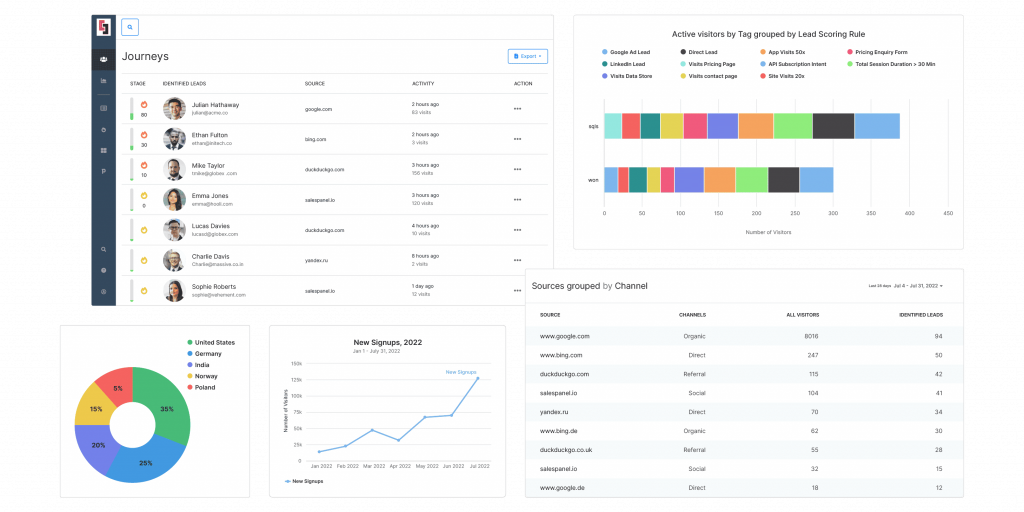
No business can convert all the leads it generates. However, with Salespanel’s website event tracking and behavioral analytics features, you can identify the exact sequence of events that lead up to and the precise moment at which a lead drops off. In order to reduce funnel drop-offs, a marketer can use this information to determine which design feature or content may be the source of the issue.
Sell more, understand your customers’ journey for free!
Sales and Marketing teams spend millions of dollars to bring visitors to your website. But do you track your customer’s journey? Do you know who buys and why?
Around 8% of your website traffic will sign up on your lead forms. What happens to the other 92% of your traffic? Can you identify your visiting accounts? Can you engage and retarget your qualified visitors even if they are not identified?
